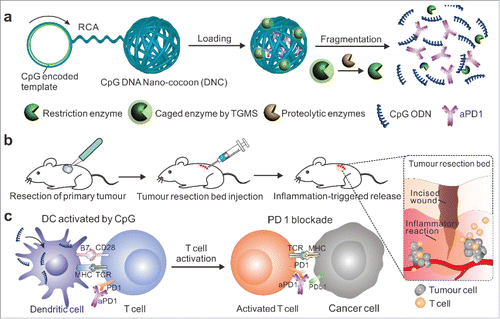Figures & data
Figure 1. Schematic of the MN patch-assisted delivery of aPD1 for the skin cancer treatment. (a) Schematic of the aPD1 delivered by an MN patch loaded with physiologically self-dissociated NPs. With GOx/CAT enzymatic system immobilized inside the NPs by double-emulsion method, the enzyme-mediated conversion of blood glucose to gluconic acid promotes the sustained dissociation of NPs, subsequently leading to the release of aPD1. (b) The blockade of PD-1 by aPD1 to activate the immune system to destroy skin cancer cells. © 2016 American Chemical Society.Citation18 Reproduced by permission of American Chemical Society. Permission to reuse must be obtained from the rightsholder.

Figure 2. Schematic illustration of delivery of CpG and anti-PD1 antibody (aPD1) by DNA nano-cocoon under an inflammation condition. (a) CpG-sequence containing DNA nano-cocoon (DNC) loaded with anti-PD1 antibody and caged restriction enzyme for inflammation-trigged fragmentation of DNC for releasing both CpG DNA and aPD1. (b) A schematic representation of in vivo tumor immunotherapy after primary tumor resection, local injection and treatment of DNC-based delivery system. (c) Released CpG DNA activates dendritic cells (DCs) to drive T cell response with aPD1 for PD 1 blockade. © 2016 Wiley-VCH. Citation26 Reproduced by permission of Wiley-VCH. Permission to reuse must be obtained from the rightsholder.

